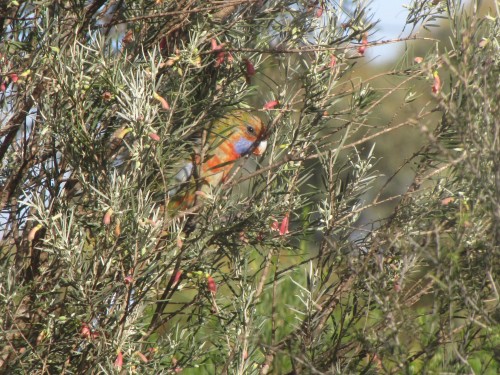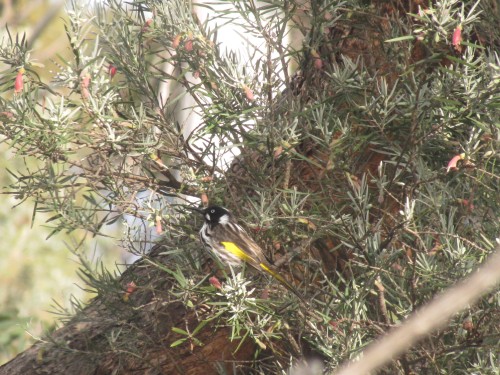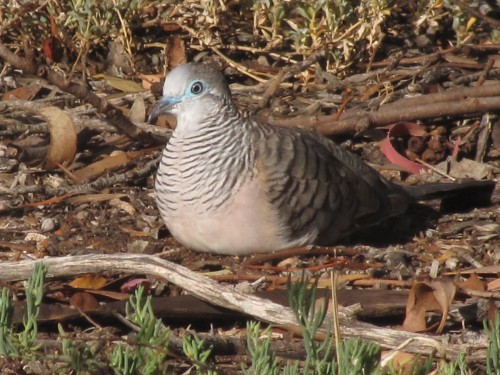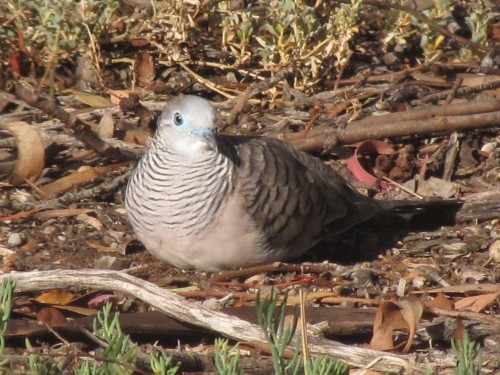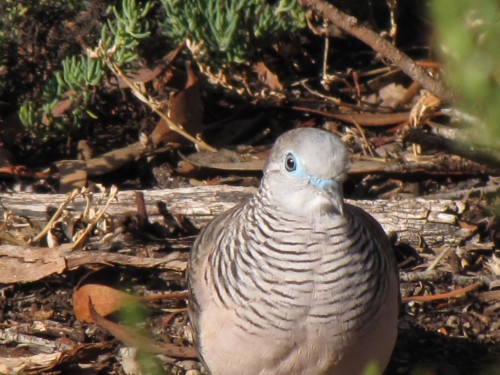Birding at Mannum South Australia
Over recent posts here I have written about a trip we went on after a visit to Adelaide for a medical appointment. We travelled home via Gorge Road, Gumeracha, Birdwood and on to Mannum for lunch. Mannum is about a half hour drive north of our home in Murray Bridge and is also situated on the banks of the Murray River.
After buying our lunch at the local bakery – excellent food, by the way – we drove the short distance to the other end of town, stopping at Lions Park on the wetlands area next to the local caravan park. This is a lagoon which is usually full of water from the adjacent main part of the river. On most occasions I find that this is quite a suitable birding area with a good variety of both water-birds and local bush birds.
As I wrote in my last post I had forgotten to bring my camera with on this trip, something I rarely forget. Consequently I had to be content with sightings using my binoculars and not get too excited about potential photos. It wasn’t long before I was really regretting my oversight regarding the camera.
As we ate our delicious lunch a colourful male and female Superb Fairy-wren came hopping across the grass only a few metres in front of our car. They would have provided me with some wonderful shots, but that was not to be.
A few moments later – as if to taunt me even further – an Australian Reedwarbler came out of the reeds nearby and it also began hopping around on the grass only metres in front of the car. Over the years I have struggled to get good shots of this bird. One hears them wherever there are reeds but one only ever catches glimpses of them scurrying from one patch to another. They don’t seem to want to stop and pose in full view and in good light so my camera can do its work. To see one hopping around in plain view was just taunting me. Never mind – I will return!
All in all it was a quite productive hour of birding. Here is a list of my sightings:
- Australian Reedwarbler
- Superb Fairy-wren
- Crested Pigeon
- House Sparrow
- Peaceful Dove
- Galah
- Purple Swamphen
- Eurasian Coot
- Little Black Cormorant
- White-plumed Honeyeater
- New Holland Honeyeater
- Masked Lapwing
- Whistling Kite
- Australian Pelican
- Silver Gull
- Noisy Miner
- Pacific Black Duck
- Grey teal
- Red Wattlebird
- Australian Magpie
- Little Corella
- Welcome Swallow
- Little Grassbird
- Caspian Tern
- Little Raven
- Magpie Lark
- Willie Wagtail
- Striated Pardalote
- Black-tailed Native Hen
- Red-rumped Parrot
I must go back again some time soon – and try to remember my camera.
Good birding
Trevor
Where’s my camera?
Last Friday my wife had a medical appointment in Adelaide. It was an early morning appointment which meant that we had most of the day to do other things. Instead of taking the quick way home via the south eastern freeway we took a far more interesting route home. We drove up through the Adelaide Hills (part of the Mt Lofty Ranges) via Gorge Road. Along the way we stopped for an extended cup of tea and delicious scones at the Big Rocking Horse at Gumeracha.
I was about to grab my camera to take some photos of the world’s largest rocking horse and some of the local bird life when I realised I had left my camera at home. I had remembered my note book and a pen to record what I saw, I had remembered my binoculars and a field guide resides permanently in the car so I don’t have to remember it. But no camera. Doh.
Oh well, I just had to be content with doing some birding via the naked eye. (Can one say “naked eye” when I do have the assistance of glasses?) Still, birding without either a camera or binoculars is good for honing one’s observation skills. I had also left the binoculars in the car while we sat in the warm restaurant having morning tea. The large picture windows make viewing the nearby landscape extremely easy and delightful.
So, without the help of any visual aids I managed to following list of birds:
- Common Blackbird
- New Holland Honeyeater
- Galah
- Little Raven
- Crimson Rosella (Adelaide Rosella)
- White Ibis
- Rainbow Lorikeet
- Australian Magpie
- Sulphur-crested Cockatoo.
- Australian Wood Duck
That’s not a great list but the conditions were difficult for the following reasons:
- It was very cold and not many birds were active
- The weather was heavily overcast and gloomy
- The scones were delicious and needed my full attention
- My wife an I were in deep conversation for over an hour discussing an important life decision I need to make shortly.
Happy birding.
Trevor
Two interesting birding blogs
It has been a while since I last featured other birding blogs here on my site. With all the writing I do, and other pressing responsibilities that life hurls at me from time to time, I don’t get nearly enough time to read many other sites about birds.
I hope to correct that oversight in coming weeks. Today I am going to feature two contrasting yet wonderful blogs, one about wildlife in general and the other specifically about birds and as a bonus, an article about bird photography.
Naturally South Australia features the ‘fascinating wild places and animals that define South Australia.’ Written and photographed by South Australian teacher and author Barry Silkstone, this blog highlights many of the things I love about my state. Of course he features many bird photos on a regular basis, and as a bonus you get photos of our animals as well. As a further bonus he writes about and photographs many of the places that make South Australia such a wonderful holiday destination, as well as a great place to live.
On the other hand Lirra Lirra: the magical mystery of birds is something else again. The author features only birds with photographs of the highest quality. Just the few featured on one recent post about Fairy-wrens made me almost weep for joy and total admiration – no, I am in awe. This site sent me scurrying to first check my bank balance, and then some camera shop sites. I thought some of my photos were rather good – until I saw this site. I really need to upgrade my camera equipment. Seriously upgrade. Sigh.
And while I am on the topic of bird photography, a few days ago I came across this article called 10 Tips for Photographing Birds. It includes some great ideas and hints on taking great shots of our wonderful birdlife.
Good birding – happy photography.
Trevor
Feeding Adelaide Rosellas
Last weekend we were having breakfast in our sun-room when four Adelaide Rosellas flew into one of the bushes in our garden, an Eremophila youngii (see photo above). I had the camera ready for many minutes but they would not come out into full sunlight and the above photo is the best I captured on this occasion. Just one bird is seen peeking out to see what was happening around it. The others were hidden in the foliage, busy feeding on the nectar in the flowers.
The Adelaide Rosella is now a frequent visitor to our garden. It is a race of the widespread Crimson Rosella and confined to the Adelaide region, Mt Lofty Ranges and mid-north of South Australia. Its occurrence here in Murray Bridge is a relatively recent extension of that range.
Parrots occurring in our garden in Murray Bridge include:
- Adelaide Rosella (regular visitor, possibly breeding)
- Crimson Rosella (occasional)
- Eastern Rosella (regular)
- Mallee Ringneck (resident breeding)
- Galah (resident breeding)
- Rainbow Lorikeet (regular)
- Purple-crowned Lorikeet (regular)
- Musk Lorikeet (occasional)
- Budgerigar (rare)
- Sulphur-crested Cockatoo (rare)
- Little Corella (occasional)
- Yellow-tailed Black-cockatoo (once only)
- Cockatiel (occasional)
- Red-rumped Parrot (occasional)
Over the years we have lived here we have planted many native Australian plants, not only for their attractiveness when they flower, but also to attract our native wildlife, especially the birds. We have quite a few eremophilas, grevilleas and correas as well as many others. The particular bush shown in the photo has flowers on it for much of the year so the rosellas and honeyeaters head for it on a daily basis. Below is another photo of the same bush, this time with a New Holland Honeyeater having a feed.
Further reading:
- Get out of my patch
- Red wattlebird in Eremophila bush
- Mallee Native Plants Nursery – my wife’s site about Australian plants
Peaceful Dove posing in the sun
One of my favourite Australian birds has to be the Peaceful Dove, shown in today’s photos. I meant to show these shots a few weeks ago when I took then, but somehow life got in the way. The photos shown today are of a solitary bird in our garden one morning. It looked like it was going to visit the nearby bird bath. Instead, it found a sunny spot to settle down for at least ten minutes – enough time for me to go to the other end of the house to collect my camera.
The Peaceful Dove is one of my favourite birds because they are quiet, gentle looking birds which come regularly into our garden. We frequently hear them calling their soft ‘toodle-doo” call, and they make no fuss at all as they flutter from tree to tree. The markings on their plumage shows delightful patterns and soft, pastel colours. Today’s photos show the colours well, lit up by the early morning sunshine.
As an extra comment on this species, I didn’t fully appreciate the beautiful blue skin around the eyes and beak. This shows up really well in today’s shots.
